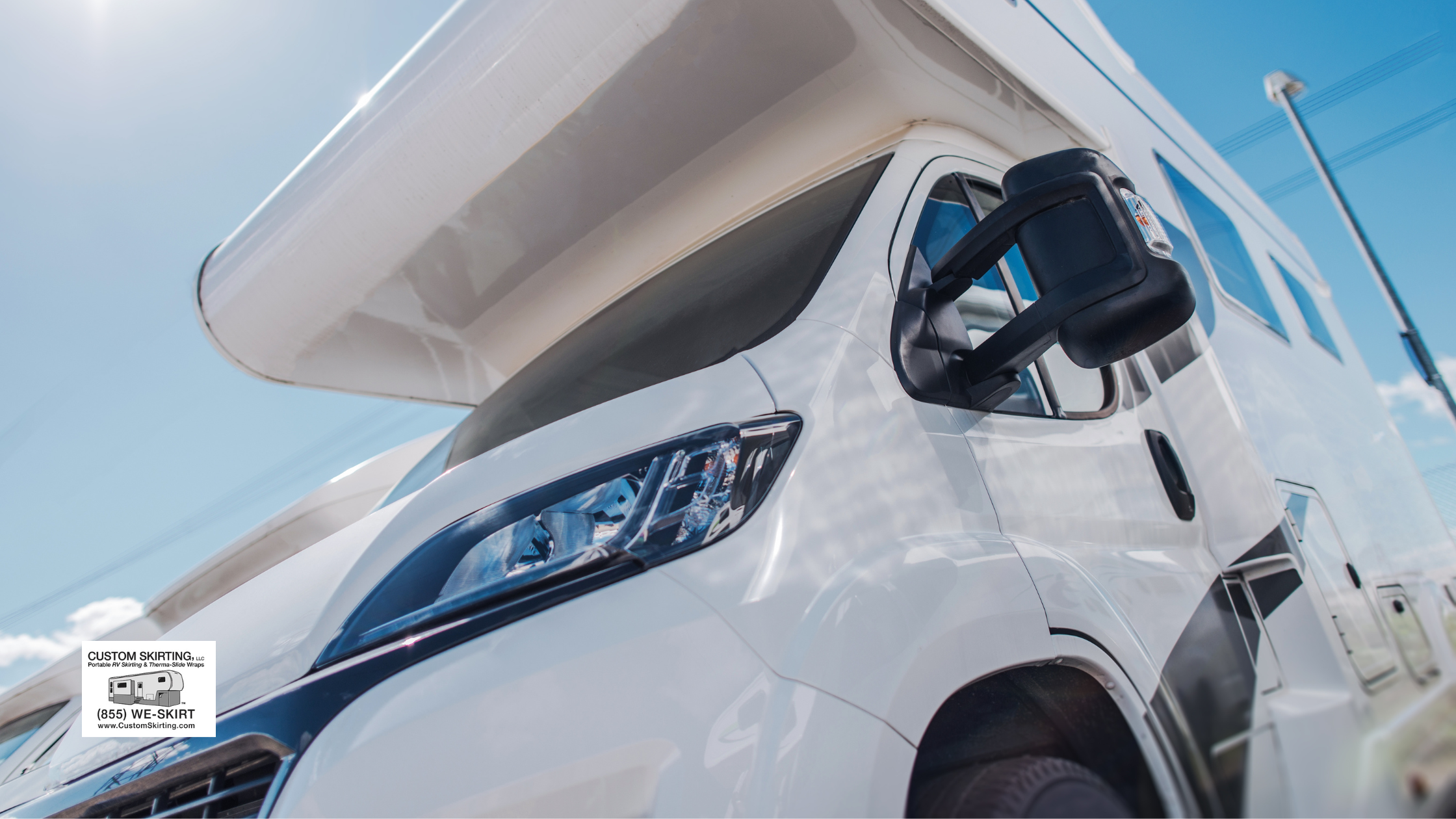
Fiberglass vs Aluminum Camper: The Right One for Your RV
Table of contents
- The Evolution of RV Construction Materials
- Understanding Aluminum Camper Construction
- Understanding Fiberglass Camper Construction
- Comparing Cost Factors
- Durability and Maintenance Comparison
- Performance Factors
- Practical Considerations for Buyers
- Making Your Final Decision
- Shield Your Camper—No Matter the Material!
- Related Articles
Choosing between a fiberglass vs aluminum camper is one of the most important decisions you’ll make when purchasing an RV. This choice not only influences your upfront investment but also impacts long-term maintenance, resale value, durability, and travel performance. The debate over aluminum vs fiberglass camper construction has continued for decades, with the market nearly split between both materials. That tells us one thing clearly: there is no one-size-fits-all answer. So, are fiberglass campers better than aluminum? The answer depends on your lifestyle, budget, and camping preferences. This guide breaks down everything you need to know about aluminum vs fiberglass travel trailer options so you can make the best decision for your next adventure. Whether you’re a weekend warrior or a full-time RVer, understanding the nuances of aluminum vs fiberglass RV construction will help you buy smart and travel happier.
The Evolution of RV Construction Materials
Early RVs were simple, often built using cloth tents mounted on frames. In the mid-20th century, steel and aluminum became popular for their strength and lightness. Aluminum revolutionized the RV industry by allowing for more mobile and affordable travel trailers. Brands like Airstream brought aluminum to the forefront with their iconic designs.
In the 1980s and beyond, fiberglass emerged as a premium material, offering smooth exteriors, better aerodynamics, and improved insulation. Today, manufacturers have refined the production processes for both aluminum and fiberglass RVs, making each more reliable, durable, and suited to specific user needs. That’s why the fiberglass vs aluminum camper debate is still so relevant.
Understanding Aluminum Camper Construction
How Aluminum Campers Are Built
Aluminum RVs are often built using the “stick-and-tin” method. This involves a wooden frame (the “sticks”) with corrugated aluminum panels (the “tin”) attached to the outside. These panels are typically layered over insulation, which is usually fiberglass batts. The framing and insulation are then covered with interior wallboard.
The construction allows for flexibility in design and cost-effective manufacturing. While the materials are lightweight, the structure is more prone to flexing than fiberglass units, which can affect durability under rough conditions.
Identifying an Aluminum Camper
You can often recognize an aluminum RV by its ridged exterior. These horizontal ridges are created by overlapping aluminum sheets. Visible seams, rivets, and paneling are all giveaways that you’re looking at an aluminum unit. These visual cues make it easier for buyers comparing aluminum vs fiberglass camper options to spot the difference on the lot.
Understanding Fiberglass Camper Construction

How Fiberglass Campers Are Built
Fiberglass campers use molded fiberglass panels or sheets applied over a welded aluminum frame. These panels are usually smooth and coated with a gel layer for a glossy, aerodynamic finish. The interior insulation often includes rigid foam, which is denser and offers better temperature and sound control compared to fiberglass batts.
Some models use one-piece fiberglass shells (especially in smaller units like Casitas), while others use multiple panels joined seamlessly. The tight construction reduces air leaks and improves weather resistance, which is a big plus when evaluating aluminum vs fiberglass travel trailer performance.
Identifying a Fiberglass Camper
Fiberglass campers have a sleek, smooth exterior with a shiny or matte finish. You won’t find seams or rivets along the body. Their polished look appeals to buyers looking for a modern aesthetic and helps with aerodynamics while towing. These visual differences are central when assessing fiberglass vs aluminum camper construction.
Comparing Cost Factors
Initial Purchase Price
Fiberglass RVs typically cost more than aluminum ones. This is due to the more complex manufacturing process and higher material costs. For example, an entry-level aluminum travel trailer might start around $20,000, while a similar-sized fiberglass model could begin at $25,000 or higher.
If you’re on a tight budget, aluminum units offer a great starting point. But if you’re wondering, “Are fiberglass campers better than aluminum?” and willing to pay extra for comfort, insulation, and resale value, the upfront cost might be worth it.
Long-term Value and Resale Considerations
Fiberglass RVs tend to hold their value better over time. Their sleek appearance, lower maintenance requirements, and modern amenities make them more desirable in the used RV market. In contrast, aluminum RVs may depreciate more quickly due to cosmetic wear and susceptibility to weather-related issues.
Still, if well-maintained, aluminum RVs can last decades. When evaluating aluminum vs fiberglass RV options, consider not just the sticker price but the entire cost of ownership over 10-15 years.
Durability and Maintenance Comparison
Aluminum Camper Durability and Maintenance
Aluminum campers are highly resistant to small dents and scratches but can be vulnerable to corrosion if not properly sealed. The wood frame inside is susceptible to rot if water leaks occur. Maintenance involves inspecting and resealing seams regularly and replacing panels if dented or damaged.
With consistent upkeep, an aluminum camper can last for many years. However, their layered construction can make repairs more challenging over time, especially if moisture penetrates the inner layers.
Fiberglass Camper Durability and Maintenance
Fiberglass campers are known for their durability and low maintenance. The smooth exterior resists water infiltration better, reducing the risk of rot or mold. However, they are prone to gel coat fading and may develop delamination if water finds its way between layers.
Maintenance includes routine washing, occasional waxing, and keeping the exterior protected from prolonged UV exposure. When considering aluminum vs fiberglass camper construction, fiberglass generally wins for long-term durability with less upkeep.
Performance Factors

Weight and Fuel Efficiency
Aluminum campers are often lighter, especially in models with smaller footprints. Their stick-and-tin construction can lead to a lower overall towing weight, which is beneficial for fuel economy.
However, fiberglass campers are typically more aerodynamic, especially with molded shapes that reduce drag. That improved aerodynamics can offset weight differences on the highway, making the aluminum vs fiberglass travel trailer debate more nuanced for tow vehicle pairing.
Insulation and Climate Control
Aluminum RVs often use fiberglass batt insulation, which is less efficient and can sag over time. In contrast, fiberglass RVs usually employ rigid foam insulation, which holds up better in both hot and cold climates.
If you plan to camp year-round or in extreme weather, fiberglass RVs offer better thermal performance. Sound insulation is also generally better in fiberglass models, contributing to a quieter and more comfortable interior.
Practical Considerations for Buyers
Matching Your Camping Style
If you’re a weekend camper who sticks to RV parks and doesn’t venture far, an aluminum RV may meet all your needs affordably. They’re lightweight, easier to tow with smaller vehicles, and cheaper to repair.
For full-timers, frequent travelers, or those who boondock in varied climates, a fiberglass camper is often the better choice. Its superior insulation, weather resistance, and modern design make it ideal for extended use.
When pondering, “Are fiberglass campers better than aluminum?” ask yourself how often you camp, where you go, and what comforts matter most to you.
Popular Brands and Models
For aluminum RVs, Airstream is the gold standard, known for its durability and timeless style. Coleman and Keystone also offer excellent aluminum-sided travel trailers at more affordable price points.
On the fiberglass side, Casita and Scamp are top-tier for molded fiberglass shell trailers. Grand Design and Forest River Rockwood provide fiberglass models with luxury features and excellent construction quality.
Researching aluminum vs fiberglass RV options by brand helps match your expectations with proven models in each category.
Making Your Final Decision
Ultimately, choosing between a fiberglass vs aluminum camper comes down to your personal needs. Start by asking:
- What is my budget?
- How often will I use the RV?
- Will I camp in hot, cold, or humid environments?
- How much maintenance am I willing to do?
- Do I plan to resell in a few years?
There is no single “best” answer to aluminum vs fiberglass camper debates. Both offer unique advantages and limitations. The key is understanding how those traits align with your travel lifestyle. When shopping, inspect both types thoroughly, paying attention to construction quality, maintenance history, and how the RV feels during a walk-through.
Shield Your Camper—No Matter the Material!
No matter if you choose a fiberglass or aluminum camper, protecting your investment is key—and that’s where custom RV skirting comes in. Our expertly tailored, on-site installation ensures a perfect fit for any RV exterior, sealing out the elements with our exclusive “No-Snap, No-Gap” system. Whether you’re braving winter chills or simply seeking better insulation, our proven skirting solution adds durability, comfort, and peace of mind. Trusted across North America for over a decade, it’s built to perform—and built to move with you.
Protect your RV with the nation’s leading skirting solution—Get your Custom Skirting today!
